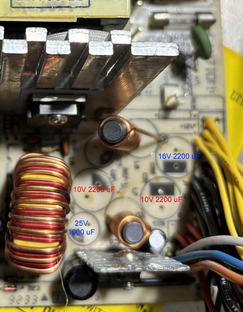behshad wrote on 2024-04-20, 09:14:is there any chance that I could know (or guess) the value of the caps so replacements can be ordered?
Give me a day or two and I should be able to trace it out from the pictures you provided.
Good thing you didn't remove the small caps by the TL494 controller too - those would have been a nightmare to figure out just from pictures.
Trashbytes wrote on 2024-04-20, 09:31:
It looks like pure chinesium with a sprinkling of backyard electrical engineering, the top right back of the board is a mess, top left looks suspect too .. board could use some ultrasonic cleaning.
Not sure how you came up with that conclusion... but if you don't have experience with power supplies, then I can understand.
If anything, the PSU shown here is actually built pretty well for an AT PSU. The primary switching BJTs are in TO-3P case (probably 2SC2526), which is clue #1 the manufacturer wasn't cutting corners. These can be pushed up to 350 Watts in some designs. Main transformer is nice and large too. And on the secondary heatsink, there's another T0-3P part (likely the 5V rectifier), which again means the manufacturer wasn't cutting corners. And the -5V rail is derived from the -12V rail via 7905 regulator, which is nice to see.
Only thing I will nick on is that the primary side EMI/RFI filter appears to be using regular metal film (PP/PE?) caps instead of proper X2-safety -rated caps. Likewise, the "Y2" caps appear to be standard 1kV ceramics. But that's not a huge issue at all.
All in all, the PSU should be able to do the rated power on its label based on the parts I see inside.
behshad wrote on 2024-04-20, 09:58:
when i got the PC and plugged it in, first there was two bangs, followed by sparks from the HDD end 12V molex connector and then there was smoke from molex and the PSU itself and then burning smell from the PSU before going quite (seriously all these happened) so this PSU is not just any old power supply it is a diva demanding attention and care 🤣
If that's truly the case, then the PSU might be in for more than just new caps.
Can't say anything more from the pictures provided, but if the fuse is blown, it will definitely be in for an overhaul.
The good news is that parts for these PSUs are readily available and they are not too hard to troubleshoot if you have *some* experience with using a multimeter to measure/check parts. Of course, whether or not that's worth doing is a totally different argument.
Trashbytes wrote on 2024-04-20, 10:10:
I think it would be easier to get an adapter that allows an ATX PSU to be used as an AT one, you wont have -5v but unless you are working with really early sound cards I doubt itll be an issue.
+1
That's usually (if not always) the easiest solution if AT PSUs are not readily available in one's location.
Back when I lived in the USA though, there were plenty of AT PSUs readily available on eBay.
On that note, always look for Astec AT PSUs - they are built like tanks and always used good quality Japanese caps. So the chances of these being bad or dying in a shower of sparks are slim to none. I had an Astec XT PSU built in the mid 80's. Figured it would die as soon as I powered it up, given that I picked it up for free from a person on Craigslist and that it had sat unused for at least 20 years (and 10 more in storage with me.) Contrary to my expectations, the PSU worked absolutely fine on the first go. I tested it with a proper load and it was still fine.
Trashbytes wrote on 2024-04-20, 10:10:
I use these with a cheap 300 watt ATX PSU that has molex, they work just fine. I find it to be safer going this path with valuable older hardware others here like their period correct AT power supplies so to each their own.
Be careful with the cheap / gutless wonder 200/300/400/xxx Watts PSUs that weight less than a baloon... especially the newer ones, which are often old designs "hacked up" for newer hardware by over-winding the transformer / O/P inductor on the 12V rail to keep it in spec under load. Such PSUs do very very poorly with a heavy(er) 5V load from an old system.




